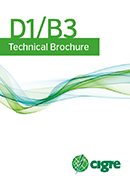Dielectric testing of gas insulated HVDC systems: CIGRE Technical Brochure 842 published with SuperGrid Institute’s input

The search for a viable substitute for the SF6 gas used in electrical equipment and HVDC systems is one of SuperGrid Institute’s main actions in our work for energy transition. Thanks to our recognised expertise in this field, we were involved in producing the CIGRE Technical Brochure 842 “Dielectric testing of gas insulated HVDC systems” which has been published after 6 years of work! Alain Girodet, SuperGrid Institute’s High Voltage Substation Equipment Programme Director, oversaw the chapter on the properties of insulating materials under DC constraints.
With the development of future HVDC networks being driven by the introduction of renewable energies, Gas Insulated Substations (GIS) will become key components of offshore platforms and onshore substations.
It is widely agreed that it is necessary to introduce a DC GIS solution to the market quickly, in light of the proven advantages of its AC GIS counterpart, such as reliability and compactness. However, the particularities of DC current led the electrical community to produce a brochure on the subject which offered a description of the relevant tests to perform in order to qualify the DC GIS. 21 contributors came together to write no less than 200 pages on the subject, including Alain Girodet who led the chapter on properties of insulating materials under DC constraints.
The first chapter of the technical brochure analyses the different electrical constraints applied by the HVDC system to define the most appropriate test procedures and test values.
The second chapter is dedicated to the basic phenomena and electrical properties of DC voltage. The transition between AC to DC electrical fields is explained and simulation requirements proposed. The electrical characteristics of insulating materials like conductivity and space charge development are also pointed out as influencing factors on electric withstand.
Diagnostic tools for monitoring insulation are well developed for AC GIS. Although a lot of work still needs to be done on this subject in relation to DC GIS, the third chapter reviews present knowledge on this specific topic.
Finally, the last chapters propose a series of type tests and routine tests to perform on the equipment in order to prove its reliability. It is important to note that DC GIS testing requires superimposed tests (application of DC voltage + impulse tests). The procedure of testing with a spark gap or a coupling capacitor to connect the DC source to the impulse source was thoroughly analysed in the brochure.
This technical brochure represents 6 years of work by numerous experts and constitutes a solid basis for a future IEC standard!


